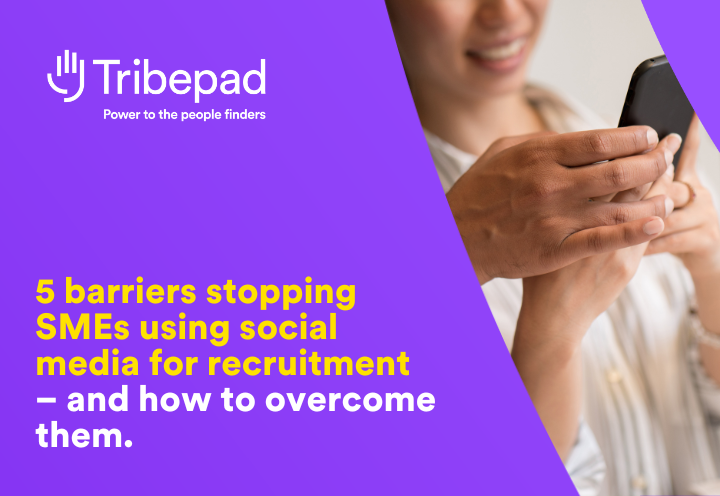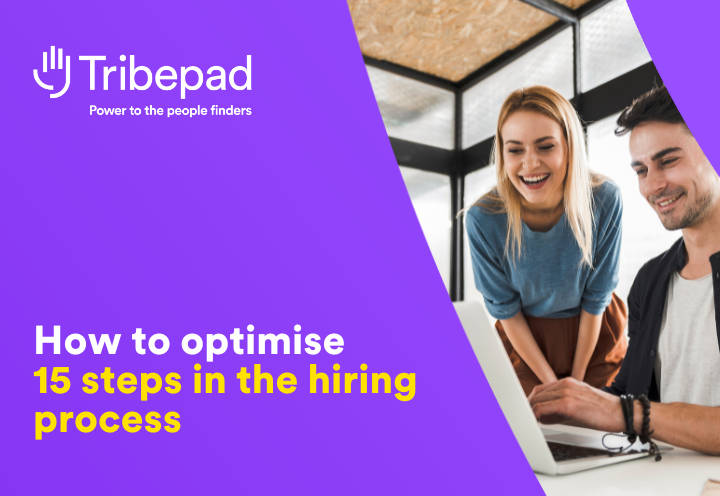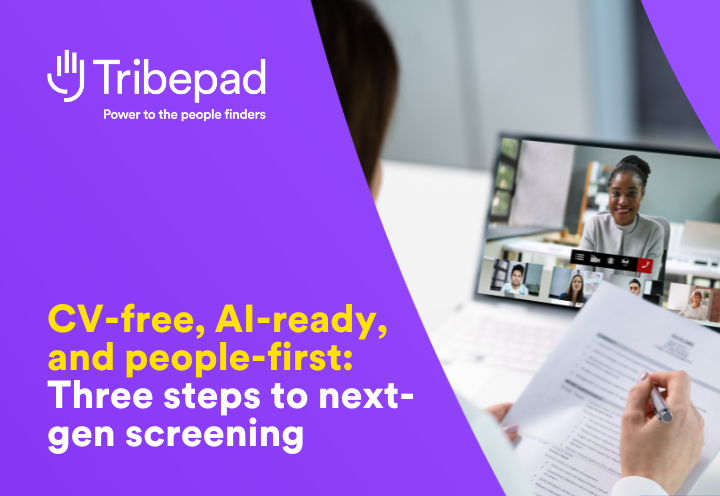COVID-19 sounds like a scenario from a doomsday sci-fi, but it’s fast becoming our new normal.
Businesses have adapted fast. It mightn’t be quite business-as-usual, but the show is definitely going on – and recruiters and HR teams have had to adapt fast too.
Many businesses had candidates in-process before COVID-19 kicked off, for example, who’re now starting in an unexpectedly challenging environment. Perhaps without ever meeting their team in-person.
And businesses in many industries are hiring in higher volumes than usual to meet increased demand. Case in point, Tribepad have seen a 3000% increase in job applications to our food retail clients.
In many cases, the entire hiring cycle is now happening virtually. From remote interviewing to remote onboarding and remote management of remote workers.

The stakes of getting remote hiring right are sky-high.
Your remote recruitment process must deliver the same excellent experience as in-person. It must bring the right people into the business, even when you’re not meeting them face-to-face. It must embed new hires into your culture and help them accelerate to full productivity.
Or the business will suffer.
Productivity will decline; engagement will decline; retention will decline. Ultimately, revenue will decline. Right when most businesses can least afford bumps in the road.
The businesses that best weather the coronavirus storm will be those who’ve maximised their biggest asset – their people. That starts with recruiters and HR teams creating a remote process that engages, nurtures and sets new hires up for success.
Authentic, empathetic and frequent communication when hiring is critical.
There’s a lot of uncertainty and anxiety flying around right now. Recruiters, managers and HR’s job is to pre-emptively answer the myriad unspoken worries your candidates and employees might have.
Easing anxiety is the first step to improving morale, engagement and ultimately productivity.
Brainstorm with your team: what’s running through your candidates’, new hires’ and employees’ heads right now?
For example:
- Candidates might be worrying you’ll pull the job at any moment, or slash the salary budget when they’re already taking a salary cut (like the laid-off BA pilot who just became a temporary delivery driver). They might’ve applied outside their normal industry and be worrying that’ll count against them. Or worrying they’ll be first in, first out, if your business starts making redundancies.
- Interviewing candidates might’ve never video interviewed before. They might be unsure of the tech and worried about how they’ll come across on camera. They might be worried about bandwidth, because the whole family are stuck home using the internet. (Hint: share this Video Interviewing Best Practices for Jobseekers with them…)
- New hires might be nervous about using your systems remotely, without in-person support to teach them the ropes. They might worry about saying the wrong thing to the wrong person, because they don’t understand your culture. They might feel anxious and isolated without in-person work friendships. If they do have to come into work, they might be worried about staying safe, especially if they have an at-risk family member.
- Current employees might be worried about their short- and long-term future. Worrying you’ll have to put them into furlough when money’s tight anyway. Or worrying the business won’t bounce back and you’ll have to look at redundancies. They might worry they’ll get into trouble for being less productive than usual because they’re juggling childcare, or don’t have the same tools to do their job as they would in the office.
Once you’ve got a list together, look at the touchpoints through the hiring cycle where you could address these potential worries.
Some ideas:
- You could add a sentence above your job adverts saying you’re welcoming applications from outside your industry and your whole recruitment team are briefed to hire for transferable skills.
- You could tailor an automated rejection email that’s sensitive and empathetic, helping applicants keep their chin up in difficult circumstances. You could even share some other businesses you know are accepting applications.
- You could create a training video that replicates the in-person training new hires get during normal onboarding. (And add that to an easy-access online portal, if you’re using Tribepad’s onboarding software.)
- You could assign more frequent hiring manager check-ins for new hires using video conferencing. You could create a questionnaire for new hires to share their feedback and worries, so you can address them personally.
- You could collate all your HR policies into one document hub, so your people could easily find answers to questions that are front of mind right now, like sick pay, part-time work, unpaid leave, company performance, and so on.
- You could message all your freelancers and contractors to share an update on your policy about external partners, and check they’re doing OK. Even if you’re freezing hiring, an empathetic message will be appreciated. And remembered.
- You could share content around working from home, or juggling work and childcare, or home exercise tips or mental health advice. Even a quick email with a film you loved over the weekend, or a game that kept your kids distracted for an hour, can help your people feel you’re on their side, in the same boat.
Authenticity is key.
Be genuine, and transparent about your own processes and challenges. We’re all facing uncertainty and change – everyone’s understanding of that, if they feel you’re treating them with respect and acting with integrity.
When all this is done, people will remember how your business made them feel during the crisis.
Are you using the right recruitment software?
The right software won’t solve all your problems (gasp!). But having the right tools to support your business through this period will make everyone’s lives easier.
We’re a recruitment software provider so it’d be weird if we didn’t think our tech was the right tech. But whatever software you use, coronavirus brings unique challenges that your technology needs to rise to meet head-on.
Like, candidate experience. Candidate experience always matters but during COVID-19 more than ever.
Before, you might’ve used video interviewing to replace telephone calls, for example, as a first stage interview. Once candidates got further through your process, you’d then meet them face-to-face, and have the chance to deliver a great in-person experience.
Now many recruiters will only meet candidates virtually – you get one shot to impress.
And onboarding. Before, you could have a whole in-person onboarding process with extensive in-person training, a mentor scheme, manager sit-downs, team lunches, Friday night drinks, and so on.
Now, your new hires might start without meeting anyone from the company in-person. Potentially for months.
(Discover why employee onboarding matters so much)
And team productivity. Your recruiters and HR folk need to collaborate in new ways, often handling increased workload while juggling new challenges. Efficiency matters more than ever.
You might already have software in place but if you’re currently weighing up options there are some crucial must-haves.
Here’s a laundry list of requirements for recruitment software that’s best-placed to cope with the demands of COVID-19:
- Comprehensive. Handles the entire recruitment process from end-to-end (makes most sense so your team don’t have to learn multiple tools, and is typically more cost-effective)
- Empathetic. Automates candidate comms so candidates are always kept in-the-loop and nobody falls through the cracks (your processes likely have more than usual right now). Poor communication is a cardinal sin at the moment.
- Easy to use for all candidates, including those who mightn’t be tech-savvy. And it should look and feel premium – giving candidates confidence in your business – not codged together at the last minute.
- Easy-to-use internally. Facilitates easy collaboration between remote recruiters, hiring managers and HR. Especially as there might be more people involved with hiring than usual, or covering jobs they mightn’t usually do.
- Flexible. Offers different methods of interviewing for different hires and seniority levels and configures easily to reflect internal processes and complex, changing workflows.
- Long-term. Adapts easily and fast to your internal processes as they evolve. So the investment has longevity, whatever happens with COVID-19.
- Smart. Offers robust reporting functionality, so recruitment and HR leaders can keep informed and adapt fast as the workforce situation changes.
- Reasonable. Uncertainty and disruption mean most businesses are tightening the purse strings. It’s crucial investments deliver compelling, proven returns.
- Supported. Many HR and recruitment teams are facing remote hiring at an unfamiliar scale and speed – they must have top-tier support when they need it, to keep things moving smoothly.
The show must go on.
COVID-19’s causing a whole load of disruption, and it sadly looks set to continue for a while yet.
Business-as-usual this isn’t – but as much as we might collectively feel like taking an extended duvet-day, businesses can’t afford to hit pause. So right now’s about trying our best to evolve, to deliver the same results in new ways.
For recruiters and HR, the end game is employees who feel supported, respected and motivated. So they can continue to be productive, whatever the world throws at them.
Tribepad provide award-winning recruitment software that’s used by 20-million people across the world.
If you’re weighing up your software options, we’d love to have a chat about how our platform could support you. Book a short exploratory call or a demo here.




